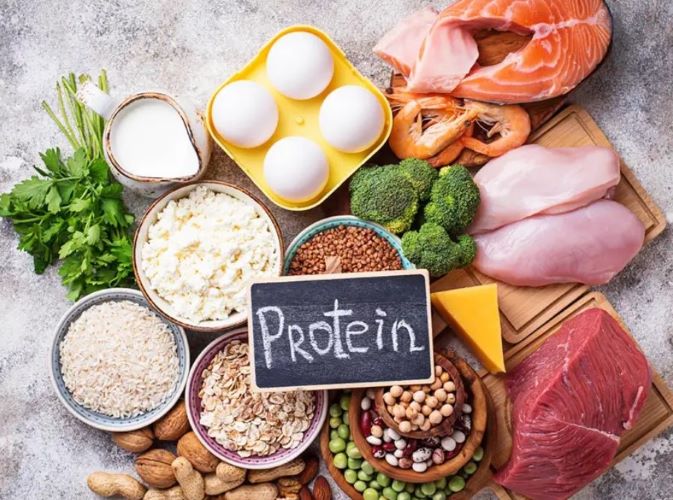From your hair to your fingernails to your muscles and pretty much every cell in your body, protein is the glue that holds it all together. One of its tasks is to make up antibodies keeping the immune system strong along with many major hormones. That’s why getting enough protein in your daily diet is so very important.
Protein is one of three macronutrients, along with fats and carbohydrates. It’s one of your body’s key building blocks, and plays an important role in supporting your cells, organs, and tissues. To ensure you are eating enough protein, aim for about one-third of your daily calories to come from protein. This translates to roughly 10% to 35% of your total calorie intake. For an average adult, this is about 200–700 calories from protein or 50-175 grams if you consume 2,000 calories daily. This does depend on your age and activity levels. A highly active athlete is of course going to need more than a sedentary person.
Here Are 7 Science-based Reasons To Eat More Protein
1. Reduces appetite and hunger levels
Eating more protein helps reduce your appetite and manage your hunger levels. This means you may be able to consume fewer calories than if you were eating higher portions of carbohydrates and fats. This is due to the better management of ‘hunger’ hormones that will drive you to keep eating if you are not getting enough quality protein. Protein’s satiety effects are partly due to its effects on several hormones that control hunger and fullness signals in your body.
The effects of protein on appetite and hunger management have also been shown to be key contributors to weight management. If you have a goal of losing weight, consider replacing some of your carbs and fats with high protein foods, such as lean meats, yogurt, beans, fish, and nuts.
2. Good for your muscles and bones
Many studies indicate that protein, including animal protein, has major benefits for muscle and bone health. For instance, a 2022 review in 1,570 participants ages 68 to 75 years found that increased protein intake played a significant role in improving bone density. Animal protein, in particular, provided more benefits than plant proteins. Research also suggests that protein intake combined with resistance (strength) training is important as you age. This will help you maintain muscle and bone mass, lowering the risk of osteoporosis and bone fractures.
3. Reduces cravings and desire for late-night snacking
A food craving is different from normal hunger. It’s not just about your body needing energy or nutrients, but your brain needing a reward. Yet, cravings can be hard to control. This may be because people usually eat ultra-processed, high sugar foods when they have cravings. These cause a quick dopamine spike but are just as quickly digested, so the brain soon wants more.
An older 2010 study in overweight men showed that increasing protein to 25% of calories reduced cravings by 60% and the desire to snack at night by half. Likewise, a 2014 study in adolescent girls that were overweight found that eating a high protein breakfast reduced cravings and late-night snacking. This may be mediated by an improvement in the function of dopamine, one of the main brain hormones involved in cravings and addiction.
4. Boosts metabolism and increases fat burning
Your body uses calories to digest and utilize the nutrients in foods, a process referred to as the thermic effect of food (TEF). Some foods require more calories to digest, which increases the TEF and, therefore, the number of calories you burn. Of all three macronutrients, protein has the highest TEF:
Protein: 20% to 30%
Carbs: 5% to 10%
Fats: 0% to 3%
A 2018 review also found that a high protein intake can boost your basal metabolic rate (BMR), which is the number of calories used to perform basic functions, such as breathing. Protein also contributes to a higher sleeping metabolic rate, which is the number of calories you burn all day long including when you are resting or sleeping.
5. Helps maintain weight loss
Increasing your protein intake is a key component of your weight loss journey because it helps:
Boost feelings of fullness
Reduce feelings of hunger
Boost metabolism (the rate your body burns fuel)
Eating a protein-rich diet can also help you maintain weight loss and prevent weight regain.
6. Helps your body repair itself after injury
Protein can help your body repair after it has been injured. According to a 2022 review, protein plays a key role in the growth, renewal, and healing process in your cells, making it the building blocks of your tissues and organs.
Protein also plays an important role in exercise recovery. Research suggests that it helps your muscles recover, repair, and regrow, which can contribute to building lean muscle mass which will burn more fuel both during exercise and when you are resting.
7. Helps you stay fit as you age
As you age, your muscles tend to gradually weaken and diminish, affecting their strength, function, and mobility. The most severe cases of muscle loss are referred to as sarcopenia (muscle loss), which is one of the main causes of frailty, bone fractures, and reduced quality of life among older adults.
Increasing your protein intake is one of the best ways to reduce age-related muscle deterioration and prevent sarcopenia. Staying physically active is also crucial, and proper strength training exercise is necessary to prevent or slowdown the decline in strength and functionality that often accompanies the accumulating years.
So in summary, eating protein-rich foods has many health, wellness and fitness benefits, including:
Speeding recovery after exercise and/or injury
Reducing muscle tissue and bone loss
Building and maintaining lean highly active muscle tissue
Helping maintain a healthy weight
Curbing hunger and intense food cravings
A well-balanced diet with proper ratios of macro nutrients (protein, healthy carbs and fats) provides all of the:
Energy you need to keep you active throughout the day.
Nutrients you need for growth and repair
Helping you to stay strong and healthy
Help prevent diet-related illness.
When you find your optimal balance and amounts of macro nutrients, you take a major step toward reaching your health goals. Your body can only absorb around 25-30 grams of protein at one time and you likely need 80-100 plus grams a day so its important to spread it over all meals and snacks throughout the day so you can meet your required amount.
Improve Protein Balance With The Addition Eating Plan
An “addition diet,” also known as nutrition by addition, focuses on adding nutrient-dense foods to your regular diet rather than restricting certain foods or calories. It emphasizes incorporating healthy options to enhance the overall nutritional value of your meals, promoting a balanced and sustainable approach to healthy eating.

The main idea is to improve the macro balance (protein, carbohydrate, healthy fats). This is not about calorie counting: It’s about paying attention to key nutrients and taking in the daily recommended portion your body needs to maintain your energy levels and overall wellbeing. A well-balanced diet with proper ratios of macro nutrients (protein, healthy carbs and fats) provides all of the: energy you need to keep active throughout the day. nutrients you need for growth and repair, helping you to stay strong and healthy and help to prevent diet-related illness.
When you find your optimal balance and amounts of macro nutrients, you take a major step toward reaching your health goals and this balance has been improved in this recipe by the addition of healthy protein.
Protein Is King When It Comes To Diet
Most people will enter nutrition coaching to upgrade the quality of food and understanding. If we were only allowed to give one lesson on nutrition; it would be to increase your protein intake and get adequate amounts. This will immediately have an impact on your total caloric intake and have you eating less of the undesirable food. This means it’s a good idea to get some protein in at each meal and snack throughout the day so you meet your needs.
Food and nutrition isn’t just about losing weight, despite what the media wants you to think. Don’t get fooled into thinking less is more. In fact, one thing we coach is that by eating more high quality food you will have more energy to move your body, train, and live a life of vitality.
This includes building quality muscle tissue, which is proven to increase your health span, metabolism, and quality of life. So, use protein as a tool to keep that tissue healthy, recovering quickly, and pain free. Experts suggest healthy adults aim for 25-30 grams of protein at meals and incorporate protein-rich snacks into their day when needed. Your body depends on protein for immune function, nutrient transport, muscle growth, and hormone synthesis.
Here Are More Ways To Reach Your Protein Requirements
Add Protein to Every Meal and Snack
You should pair every meal and snack with a protein source. Regularly eating protein-rich foods helps you feel full and stabilizes blood sugar between meals. Including high-protein foods at each meal can help you reach your protein intake goals and support muscle growth, satiety, and blood sugar regulation.23
Eat More Legumes
Legumes, including beans and lentils, are one of the richest sources of plant protein you can eat. They are rich in protein and fiber, promoting feelings of fullness. Legumes are also rich in nutrients often not found in animal-based protein sources, like vitamin C, folate, and magnesium.
Swap Cereal for Higher-Protein Options
There are exceptions, but most breakfast cereals are low in protein. A 1-cup serving of Cheerios contains just 3.5 grams of protein. Swapping cereal for higher-protein breakfast dishes can help you increase your daily intake. A simple breakfast made with one 7-ounce container of plain Greek yogurt, 1 ounce of pumpkin seeds, and 1 cup of raspberries contains 30 grams of protein and takes just minutes to prepare. Not only is this a more nutritious choice, but the fiber and protein will help you stay full until your next meal or snack.
Add Collagen to Your Coffee and Tea
Research has shown that collagen supplements can offer several benefits. They improve skin health, increase bone mineral density, and manage osteoarthritis symptoms. Collagen is tasteless, and you can add it to hot and cold drinks like coffee, tea, and smoothies. You can also use it in chia puddings, energy balls, and overnight oats. Collagen peptides provide around 12 grams of protein per 14-gram serving.
Use Nuts and Seeds in Plant-Based Recipes
Nuts and seeds are convenient, ready-to-eat sources of protein. You can enjoy them on their own as a snack or add them to salads, oatmeal, and baked goods for a boost of plant-based protein. The protein content of nuts and seeds varies. Pumpkin seeds, almonds, pistachios, and hemp seeds are among the richest sources. Hemp seeds provide nearly 10 grams of protein per 3-tablespoon serving.

Buy Greek Yogurt Over Regular
Switching from regular yogurt to Greek yogurt is a simple way to increase your protein intake. Greek yogurt is thicker and more concentrated than regular yogurt. It also contains more than twice the amount of protein per serving. A 7-ounce container of Greek yogurt provides 20 grams of protein. The same serving of regular yogurt contains just 9 grams. Greek yogurt is also lower in carbohydrates than regular yogurt. It can be a good choice for people who need to manage their blood sugar levels, such as those with type 2 diabetes.
Eat High-Protein Carbohydrates
Carbohydrates like white pasta and white rice are relatively low in protein. One cup of white rice provides just 4 grams of protein. Prioritizing high-protein carbohydrates is an easy way to increase your intake of this important nutrient. Try out options like quinoa, other ancient grains and bean-based pasta. Pairing these choices with foods like chicken, fish, and beans will boost the protein content of your meal even more.
Use Protein Powder in Low-Protein Dishes
Protein powders can make smoothies and shakes more filling and nutritious. Most options provide around 25 grams of protein per serving. Protein powders also make an excellent addition to recipes like overnight oats, chia pudding, plant-based yogurts, and baked goods like muffins and bread. Choose protein powders that are free from added sugars whenever possible. Many protein powders are sweetened with stevia or monk fruit, both of which are blood sugar-friendly sweeteners.
Keep Protein-Rich Snacks On-Hand
Stocking your kitchen, car, and work desk with healthy, high-protein products can ensure you always have a protein-rich snack on hand when hunger strikes. Research has shown that protein-rich snacks may reduce your overall calorie intake and promote fat loss. Opt for turkey sticks, roasted chickpeas, protein bars, individually packaged roasted nuts, or nut butter packets. Protein powder, Greek yogurt, and seeds are other high-protein ingredients that you can add to baked and unbaked recipes to boost their protein content.
If you are looking for more delicious, healthy, protein-rich, no bake desserts and treats to help you reach your health, wellness and fitness goals, you will love my collection here: Blended Bites
As well as being really easy to make, these ‘healthified’ recipes are better for you than your average desserts, snacks and treats as they are made with wholesome REAL food ingredients that includes protein.
This makes them more balanced than the traditional high carb recipes. Old fashioned baked recipes always have tons of sugar, carbs and fats. The new modern way it to add protein making the recipe more balanced and healthy.
Set yourself up for success and make yourself strong and healthy.


